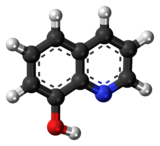8-Hydroxyquinoline

| |

| |
| Names | |
|---|---|
| IUPAC name
Quinolin-8-ol, 8-Quinolinol
| |
| Other names
1-azanaphthalene-8-ol, Fennosan H 30, hydroxybenzopyridine, hoxybenzopyridine, oxychinolin, oxyquinoline, phenopyridine, quinophenol, oxine
| |
| Identifiers | |
3D model (JSmol)
|
|
| ChEBI | |
| ChEMBL | |
| ChemSpider | |
| ECHA InfoCard | 100.005.193 |
| KEGG | |
PubChem CID
|
|
| UNII | |
CompTox Dashboard (EPA)
|
|
| |
| |
| Properties | |
| C9H7NO | |
| Molar mass | 145.16 g/mol |
| Appearance | White crystalline needles |
| Density | 1.034 g/cm3 |
| Melting point | 76 °C (169 °F; 349 K) |
| Boiling point | 276 °C (529 °F; 549 K) |
| Pharmacology | |
| G01AC30 (WHO) A01AB07 (WHO) D08AH03 (WHO) R02AA14 (WHO) | |
| Hazards | |
| Occupational safety and health (OHS/OSH): | |
Main hazards
|
flammable |
| Safety data sheet (SDS) | External MSDS |
Except where otherwise noted, data are given for materials in their standard state (at 25 °C [77 °F], 100 kPa).
| |
8-Hydroxyquinoline is an organic compound with the formula C9H7NO. It is a derivative of the heterocycle quinoline by placement of an OH group on carbon number 8. This light yellow compound is widely used commercially, although under a variety of names.[2][3]
Synthesis
It is usually prepared from quinoline-8-sulfonic acid and from Skraup synthesis from 2-aminophenol.[4]
As a chelating agent
8-Hydroxyquinoline is a monoprotic bidentate chelating agent. In neutral solution, the hydroxyl is in the protonated form (pKa=9.89) and the nitrogen is not protonated (pKa=5.13).[5] However, an excited-state zwitterionic isomer exists in which H+ is transferred from the oxygen (giving an oxygen anion) to the nitrogen (giving a protonated nitrogen cation).[6]
Applications
The complexes as well as the heterocycle itself exhibit antiseptic, disinfectant, and pesticide properties,[7][8] functioning as a transcription inhibitor.[9] Its solution in alcohol is used in liquid bandages. It once was of interest as an anti-cancer drug.[10]
The reaction of 8-hydroxyquinoline with aluminium(III)[11] results in Alq3, a common component of organic light-emitting diodes (OLEDs). Variations in the substituents on the quinoline rings affect its luminescence properties.[12]
The roots of the invasive plant Centaurea diffusa release 8-hydroxyquinoline, which has a negative effect on plants that have not co-evolved with it.[13]
Hydroxyquinoline was used as a stabilizer of hydrogen peroxide in a rocket fuel oxidizer (T-Stoff) for the German Messerschmitt Me 163 Komet in World War 2.[citation needed]
Related compounds
Related ligands include the Schiff bases derived from salicylaldehyde, such as salicylaldoxime, salen, and salicylaldehyde isonicotinoylhydrazone (SIH). 8-Mercaptoquinoline is the thiol analogue of 8-hydroxyquinoline.
References
- ^ Nanjing Odyssey Chemicals
- ^ "8-Hydroxyquinoline Safety Data". Oxford University.[dead link]
- ^ "8-Hydroxyquinoline". PAN Pesticides Database.
- ^ Collin, G.; Höke, H. (2005). "Quinoline and Isoquinoline". Ullmann's Encyclopedia of Industrial Chemistry. Weinheim: Wiley-VCH. doi:10.1002/14356007.a22_465. ISBN 978-3527306732.
- ^ Albert, A.; Phillips, J. N. (1956). "264. Ionization Constants of Heterocyclic Substances. Part II. Hydroxy-Derivatives of Nitrogenous Six-Membered Ring-Compounds". Journal of the Chemical Society (Resumed). 1956: 1294–1304. doi:10.1039/JR9560001294.
- ^ Bardez, E.; Devol, I.; Larrey, B.; Valeur, B. (1997). "Excited-State Processes in 8-Hydroxyquinoline: Photoinduced Tautomerization and Solvation Effects". The Journal of Physical Chemistry B. 101 (39): 7786–7793. doi:10.1021/jp971293u.
- ^ Phillips, J. P. (1956). "The Reactions of 8-Quinolinol". Chemical Reviews. 56 (2): 271–297. doi:10.1021/cr50008a003.
- ^ "8-Hydroxyquinoline". Medical Dictionary Online.
- ^ "8-Hydroxyquinoline". Sigma-Aldrich. Retrieved 2012-05-23.
- ^ Shen, A. Y.; Wu, S. N.; Chiu, C. T. (1999). "Synthesis and Cytotoxicity Evaluation of some 8-Hydroxyquinoline Derivatives". Journal of Pharmacy and Pharmacology. 51 (5): 543–548. doi:10.1211/0022357991772826. PMID 10411213.
- ^ Katakura, R.; Koide, Y. (2006). "Configuration-Specific Synthesis of the Facial and Meridional Isomers of Tris(8-hydroxyquinolinate)aluminum (Alq3)". Inorganic Chemistry. 45 (15): 5730–5732. doi:10.1021/ic060594s. PMID 16841973.
- ^ Montes, V. A.; Pohl, R.; Shinar, J.; Anzenbacher, P. Jr. (2006). "Effective Manipulation of the Electronic Effects and Its Influence on the Emission of 5-Substituted Tris(8-quinolinolate) Aluminum(III) Complexes". Chemistry: A European Journal. 12 (17): 4523–4535. doi:10.1002/chem.200501403. PMID 16619313.
- ^ Vivanco, J.M.; Bais, H.P.; Stermitz, F.R.; Thelen, G.C.; Callaway, R.M. (2004). "Biogeographical variation in community response to root allelochemistry: novel weapons and exotic invasion". Ecology Letters. 7 (4): 285–292. doi:10.1111/j.1461-0248.2004.00576.x.
